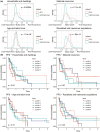Distinct characteristics and social determinants in adult T-cell leukaemia/lymphoma patients at a tertiary cancer centre in Canada
- PMID: 40328512
- PMCID: PMC12234277
- DOI: 10.1111/bjh.20132
Distinct characteristics and social determinants in adult T-cell leukaemia/lymphoma patients at a tertiary cancer centre in Canada
Abstract
Adult T-cell leukaemia/lymphoma (ATLL) is a rare, aggressive haematological malignancy linked to human T-cell leukaemia virus type I (HTLV-1) and associated with poor outcomes. Despite its higher prevalence in HTLV-1-endemic regions, the relationship between clinical characteristics and patients' sociocultural background remains underexplored. We retrospectively analysed 79 ATLL patients treated at our institution (1993-2023). The median age at diagnosis was 47 years, and 72% of patients were of Caribbean origin. Median progression-free and overall survival were 10.2 and 16.2 months, respectively, with only five patients receiving allogeneic stem cell transplantation. Central nervous system (CNS) involvement at diagnosis occurred in 22% of patients and was associated with worse outcomes, while 14% experienced CNS relapse within a median of 4.9 months. Using the Ontario Marginalization Index, we found higher levels of material, household/dwelling and racialized/newcomer-related marginalization compared to the general Greater Toronto Area population, though these factors were not linked to poorer outcomes. Our findings reveal that ATLL patients in this cohort were predominantly of Caribbean descent, presented at a young age and faced significant CNS involvement and poor survival outcomes, underscoring ATLL as an unmet clinical need.
Keywords: HTLV‐1; adult T‐cell leukaemia/lymphoma (ATLL); central nervous system involvement; haematological malignancy; health disparities; retrospective cohort.
© 2025 The Author(s). British Journal of Haematology published by British Society for Haematology and John Wiley & Sons Ltd.
Conflict of interest statement
The authors declare that there are no conflicts of interest related to the work presented in this manuscript.
Figures



Similar articles
-
Do Patients of Different Levels of Affluence Receive Different Care for Pediatric Osteosarcomas? One Institution's Experience.Clin Orthop Relat Res. 2025 Apr 1;483(4):748-758. doi: 10.1097/CORR.0000000000003299. Epub 2024 Oct 30. Clin Orthop Relat Res. 2025. PMID: 39485923
-
Chimeric antigen receptor (CAR) T-cell therapy for people with relapsed or refractory diffuse large B-cell lymphoma.Cochrane Database Syst Rev. 2021 Sep 13;9(9):CD013365. doi: 10.1002/14651858.CD013365.pub2. Cochrane Database Syst Rev. 2021. PMID: 34515338 Free PMC article.
-
Nivolumab for adults with Hodgkin's lymphoma (a rapid review using the software RobotReviewer).Cochrane Database Syst Rev. 2018 Jul 12;7(7):CD012556. doi: 10.1002/14651858.CD012556.pub2. Cochrane Database Syst Rev. 2018. PMID: 30001476 Free PMC article.
-
Optimisation of chemotherapy and radiotherapy for untreated Hodgkin lymphoma patients with respect to second malignant neoplasms, overall and progression-free survival: individual participant data analysis.Cochrane Database Syst Rev. 2017 Sep 13;9(9):CD008814. doi: 10.1002/14651858.CD008814.pub2. Cochrane Database Syst Rev. 2017. PMID: 28901021 Free PMC article.
-
Restrictive versus liberal red blood cell transfusion strategies for people with haematological malignancies treated with intensive chemotherapy or radiotherapy, or both, with or without haematopoietic stem cell support.Cochrane Database Syst Rev. 2017 Jan 27;1(1):CD011305. doi: 10.1002/14651858.CD011305.pub2. Cochrane Database Syst Rev. 2017. Update in: Cochrane Database Syst Rev. 2024 May 23;5:CD011305. doi: 10.1002/14651858.CD011305.pub3. PMID: 28128441 Free PMC article. Updated.
References
-
- Shimoyama M. Diagnostic criteria and classification of clinical subtypes of adult T‐cell leukaemia‐lymphoma. A report from the Lymphoma Study Group (1984–87). Br J Haematol. 1991;79(3):428–437. - PubMed
-
- Ishitsuka K. Diagnosis and management of adult T‐cell leukemia/lymphoma. Semin Hematol. 2021;58(2):114–122. - PubMed
MeSH terms
Grants and funding
LinkOut - more resources
Full Text Sources

